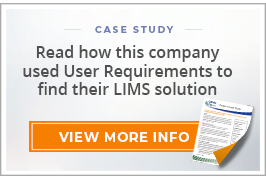Don’t Try Your Luck at a Solo LIMS Selection-Work with an Expert

Everyone feels lucky on St. Patrick’s Day (unless you’re an island-dwelling snake). It takes wisdom, however, to recognize that “Luck is what happens when preparation meets opportunity.” (Seneca said that 2000 years ago, but he was speaking in ancient Latin.) So, today is your lucky day; this is your opportunity to learn what preparation you need to undertake a successful LIMS selection process. It’s our business to impress upon you, in plain English, the wisdom of working with a consultant in making your LIMS selection.
There are a number of legitimate reasons why you should engage a consultant to help. Bringing in an expert to advise throughout the process ensures that you end up with the LIMS that is best suited for your lab and your processes. Herein, we’ll look at some of the specific ways that CSols can help you with your LIMS selection.
LIMS Selection Is Not A Popularity Contest
Is anyone hearing their mother’s voice right now? Turns out, mom was right, at least as far as popularity contests (and LIMS selections) go. The most popular LIMS on the planet may not have the features your organization needs, and therefore, wouldn’t be the right LIMS for you.
All LIMS come with out-of-the-box (OOTB) settings. Some are common across all LIMS platforms, like sample and test settings, user privileges, and reporting and analytics capabilities. Some are unique to the chosen LIMS, like the LabVantage Pharma module that has specific features for pharmaceutical laboratories. However, all LIMS will require some configuration of those OOTB settings to make the system fit for your lab’s purposes. The level of configuration needed to bring the LIMS in line with your lab’s processes and workflows will vary. Configuration and customization (if necessary) add significant costs to the bottom line of a LIMS. An expert consultant can advise about how much configuration or customization would be needed to meet your lab’s requirements.
Speaking of requirements, a best practice when selecting a LIMS is to request a demo from the vendor. Closing your eyes and pointing at a random name is not the type of luck you want in this decision. At CSols, we suggest having a set of written user requirements to use when evaluating each LIMS. This helps you make an unbiased decision. Be aware that the vendors can only share so much during a demo. A qualified consultant with experience across different LIMS products can help to fill in the gaps for a full picture of the software’s capabilities and how those would translate to your lab.
The impartial view of an outside consultant can be invaluable in a LIMS selection process. The vendor-neutral approach taken by CSols consultants allows our clients to carefully weigh their requirements against the qualities of several LIMS, without being swayed by popularity or shiny features. In the end, our clients receive a LIMS that best fits their workflows, and we stay with our clients to facilitate organizational change management (OCM) and ensure that user adoption is complete and a positive experience. Clients also get the benefit of not having to be the bearer of bad news to LIMS vendors that are not selected.
LIMS Selection Involves Considerations Outside The Lab
A crucial part of ensuring your LIMS selection process provides you with the best system for your organization is to understand the needs of all the end users of your lab data. Some of the end users will be outside the lab, such as quality control and business managers.
- What kind of outputs do your end users need to make their decisions from that data?
- Will your selected LIMS be able to provide the necessary reports without expensive configuration or customization?
- What workflow changes will be needed to make the best use of the available reporting options?
To be sure all end users will be satisfied with your LIMS selection, give them all a voice in the requirements-gathering process.
Don’t try your luck at guessing what you think the end users need—that never ends well. A CSols consultant can help you identify nonlaboratory users of your data and ask them the right questions to be sure their needs are addressed. In addition, a CSols consultant will work with all stakeholders, in the lab, and across the broader organization, to provide appropriate organizational change management advice.
LIMS Selection Presents Opportunities For Company-Wide Efficiencies
In the process of talking to stakeholders to gather requirements, your organization will uncover some of its hidden, or dark, data. Efforts could be extended to centralize all your organization’s data using the LIMS selection process as the driver. LIMS selection presents an opportunity to bring that data to the forefront for years of improved productivity through data-driven decision making. An overarching data strategy recognizes that a LIMS is only part of your organization’s data architecture.
Luck is not enough to get you to the desired state of efficiency we’ve outlined here. That requires skill and experience. CSols consultants are uniquely positioned to help organizations foreground that hidden data and reimagine the approach to data. Our broad experience is not only within laboratories and across organizations, but also in data architectures. We can help your organization imagine new connections between and among your various data sets. There are efficiencies to be gained beyond the lab when choosing a LIMS, and you may not be aware of all of them.
LIMS Selection Pitfalls
Like any process, when steps are not fully executed at the proper time, cost overruns can occur. For example, some of the most important questions in a LIMS selection process should be asked in the early stages of the project, before it’s too late to change the answer.
Other pitfalls to avoid are:
- Extensive Customization: Providing appropriate demonstration scripts for your selected vendors helps to understand how much functionality is available OOTB and whether extensive configuration or customization will be needed. It is a best practice to minimize customization and configuration.
- Inadequate Resources: Ensuring that your implementation team will have the time and the skills necessary to sustain the project after the LIMS selection also will reduce risk.
- Regulatory Warnings: Understanding your organization’s regulatory needs and what should and should not be validated, and by whom, can help to avoid undesirable outcomes during audits by regulatory authorities.
If you’d rather not try your luck going solo with your LIMS selection, CSols can help you.
▶ Related Reading: How Do We Choose the Best LIMS Software
Turn one lucky day (today!) into years of good fortune for your organization by taking these preparations to heart. When your next LIMS selection opportunity arises, we will be ready to help.
Are you feeling lucky enough to get everything right in your LIMS selection?



















